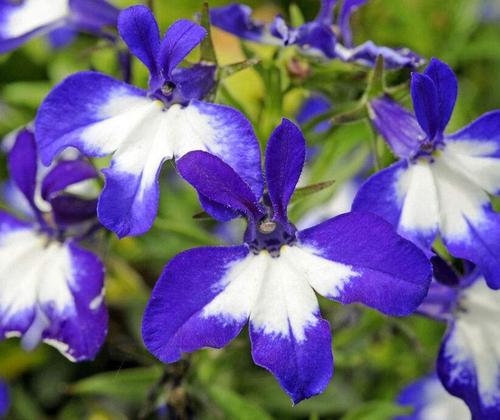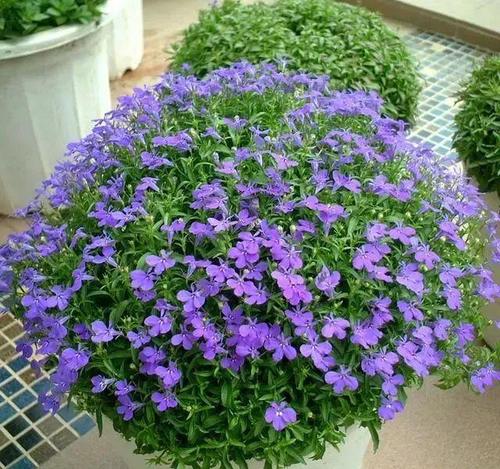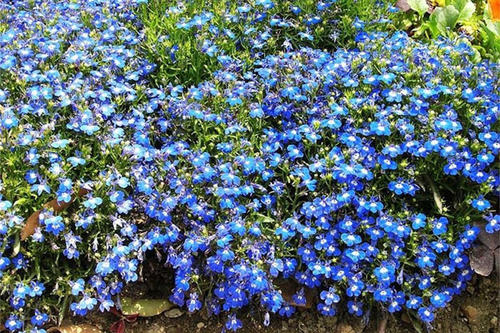Lobelia Profile: Info, Care, Propagation, Uses
Written by Maggie
Oct 28 2021

Lobelia is a species of Lobelia belonging to the genus Lobelia in the Platycodon family, also known as Lobelia erinus in the Platycodon family. It is a perennial herb, cultivated annually, semi-vine, spread on the ground, smooth or slightly hairy on the lower part, with slender branches. Leaves are vopposite, much leaved, lower leaves spatulate, crenate, apex obtuse, upper leaves oblanceolate, subapical leaves broadly linear and acute; Racemes are terminal, florets long-stalked.
Lobelia is commonly used as a flower bed, at the edge of flower borders, and has certain medicinal properties. Lobelia is an easy-to-grow, carefree plant that enjoys cool weather. This plant bloom in summer and will continue to produce flowers to the first frost. growing lobelia is an asset to the garden.
Lobelia Picture

Lobelia Info
| Botanical Name | Lobelia erinus |
| Common Names | Annual lobelia, edging lobelia, lobelia, Cardinal flower, Indian Tobacco, Edging Lobelia, Asthma Weed, Vomitweed, Pukeweed |
| Plant Type | Tender perennial |
| Sun | Full sun to part shade |
| Hardiness Zones | 10 to 11 |
| Flower color | Blue, lilac-pink, purple, white, cherry-red |
| Native Area | Southern Africa |
| Mature size | 6 to 9 inches in height, with a slightly greater spread |
Characteristics of Lobelia
The Lobelia plant is about 12~20 cm tall, and the stems and branches are fine. The upper leaves of the stem are smaller and lanceolate, and the leaves near the base are slightly larger, spatulate and alternate. The flower top is born or axillary, corolla apex five lobes, the lower 3 lobes are larger, the shape is like butterfly wings, the color has red, peach, purple, purple, white and other colors.
Habits of Lobelia
Lobelia flowers only when exposed to long hours of sunlight and low temperatures.
Lobelia is not strong in cold tolerance, avoids extreme heat, and prefers loam rich in humus.
When to grow Lobelia
In spring, after the danger of frost has passed.
Where to grow Lobelia
Most prefer moist, hummus-rich, slightly acidic soil. Some perennial varieties, such as cardinal flower, prefer boggy conditions and can even be grown in standing water.
How to care for Lobelia
Lobelia Lighting
In midsummer, most will need some shade to keep them blooming, with the exception of those with improved heat tolerance.
Lobelia Watering
Water regularly to keep the soil evenly moist, especially during hot, dry weather. Container-grown plants may need daily watering to maintain consistent soil moisture.
Lobelia Fertilizer
Perennial varieties can usually get by with a yearly application of fertilizer or compost in the spring. For annuals, fertilize more frequently or apply a continuous-release fertilizer for flowering plants to sustain them throughout the growing season.
Lobelia Pruning
Most annual lobelias are self-cleaning, so you don’t need to deadhead them. If blooming slows during the heat of summer, the best way to revive them is to cut them back by as much as one-half to two-thirds, followed by regular watering. This radical pruning will regenerate new growth, and by the time the cooler weather of fall arrives, your plants should be in full bloom again. You can also pinch back plants at any time if you prefer bushier growth.
Lobelia Winter Care
If perennials are covered with heavy mulch over the winter, the roots can rot, especially in warmer southern climates. If you typically mulch your perennial beds to prevent frost heaving and root damage, use a light layer of mulch that won’t completely cover the basal leaves.

Growing Lobelia from Seed
Although annual types are widely available at garden centers in the spring, you can also start your own plants from seed, sown indoors 8 to 10 weeks before the last spring frost date. Don't transplant seedlings outdoors until a few weeks after the last frost date. Perennial lobelias will often self-sow given the right conditions and usually bloom the first year from seed.
Lobelia can be sown in autumn, winter or early spring.
Lobelia Varieties
Although there are hundreds of lobelia varieties, these are the types most commonly grown in the home garden:
Edging lobelias (Lobelia erinus) and their hybrids are tender perennials grown as warm-weather garden annuals. Often grown as container and edging plants, they can have bushy or trailing habits. The tiny five-petaled flowers bloom in shades of blue, purple, rose, and white, with some accented by white eyes.
Cardinal flower (Lobelia cardinalis), named for its showy spikes of scarlet-red flowers, is the most popular perennial variety. Some varieties also have ornamental reddish-bronze foliage. A North American wildflower native to wet areas, the cardinal flowers can be found growing in marshes, stream banks, and low woods.
Great blue lobelia (Lobelia siphilitica), also called blue cardinal flower, is another native perennial wildflower that bears long-lasting bright blue flowers.
Lobelia ×speciosa are popular garden hybrids (usually of L. cardinalis and L. siphilitica) with flowers in shades of blue, lavender, pink or red and a long summer bloom period.
Lobelia Uses
Medicinal Value
Lobelia can treat snakebite; Carbuncle swelling boils; Tonsillitis; Eczema; Athlete's foot. Lobelia can treat fall injury; damp-heat jaundice; Appendicitis. Inflammatory bowel disease. Nephritis; Cirrhosis ascites and a variety of cancers.
Garden Use
The unique blue flower variety of Lobelia is an important variety of spring flower beds.
Lobelia is a bloated, round plant nearly filled with flowers. It is suitable for flower beds, potted plants, hanging pots and landscaping. Lobelia is popular with families in Europe and the United States.

Read Next:
Top 10 Most Beautiful Roses in the World
Top 10 Most Beautiful Flowers in the World
26 Best Autumn Flowers to Plant for Fall Color in Garden
Latest Updated
- Benefits of Bugleweed - 7 Science-backed Health Benefits
- Bugleweed Dangers & Side Effects - Is It Poisonous?
- How to Plant Evergreen Trees - What You Should Know
- When to Plant Evergreens - Grow Guide for Evergreen Trees
- 12 Wonderful Evergreen Shrubs for Your Garden
- 12 Popular Evergreen Plants with Pictures for Beginners
- When And How To Prune A Lilac Bush Like a Pro
- How to Grow & Care for Lilac Vine (Hardenbergia Violacea)
- Japanese Lilac Tree (Syringa Reticulata) Care & Propagation Guide
- Shumard Oak Pros and Cons - What to Know
Popular Articles
- Winter maintenance of Antirrhinum Majus
- How to Grow Terminalia Mantaly Tree
- How to Grow and Care for Crossostephium Chinense
- How to grow Antirrhinum Majus in spring
- Peristeria Elata (Dove Orchid) Profile: Info & Care Guide
- Underwatered Snake Plant (Sansevieria Trifasciata) - Signs And How To Fix
- How to Care for Brazilian Jasmine Plant (Mandevilla Sanderi)
- How to Grow & Care for Graptopetalum Purple Delight in Summer
- Rosa Chinensis (China Rose): Plant Growing & Care Tips
- How to Care for Baby Sun Rose (Aptenia Cordifolia)